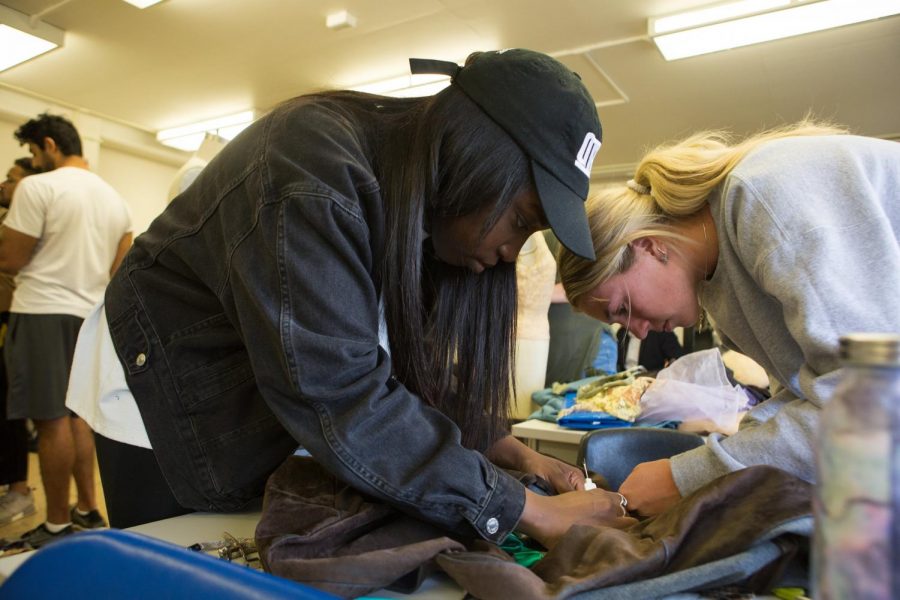Class shows complexity of fashion
Jasmiat Oyolola (left), senior in ACES, undoes sewn stitches for a garment. Lindsay Lathrop (right), freshman in FAA, works alongside her for the RE-FASHIONED fashion show for ARTS 299: Special Topics in Art.
Apr 15, 2019
When Jasmiat Oyolola, senior in ACES, learned the University was going to have a hands-on fashion design class, she knew that she should take it.
Oyolola is minoring in Art + Design because she aspires to work in the fashion industry.
“I found out about this class my sophomore year and I took it, but then it was online,” Oyolola said. “I really just decided to take it out of … my interest working in fashion. This year, I saw that it was being offered again, but in person, so I immediately signed up.”
The class is taught by Susan Becker, clinical assistant professor at the School of Art + Design. Becker also teaches an introductory fashion class, which Oyolola says focuses on design and working with different materials.
Becker teaches from her own experiences within the fashion industry.
Get The Daily Illini in your inbox!
After graduating from the Rhode Island School of Design with a bachelor’s in Apparel Design, Becker immediately moved to New York City and started working for various designers in different positions.
She hopes the experience she has acquired in her previous jobs and working as a designer can help her students learn about fashion.
“I just appreciate so much to have been able to bring all that variety of experience to teaching, and I really had a little bit of a window into a lot of different aspects of the industry,” she said.
The class itself can accommodate any student from any major, minor or concentration.
Becker cannot pinpoint there being a certain “type” or kind of student in her class, and that is what she loves about teaching this specific course.
“I love that I cannot say there is a typical student,” she said. “I get students from all over campus with different backgrounds, different majors. This is my 13th year teaching at the University, and I get students from all different disciplines and majors.”
This is what makes teaching the subject at the University so exciting, like seeing an art major interact and learn something they didn’t know from a Chemistry major and becoming friends, Becker said.
Currently, students in the class are working on their final project, which includes wrapping up all previous collections and making another mini collection for an end-of-year fashion show.
This show showcases their final project collections and is called “RE-FASHIONED,” happening on May 4 at 7 p.m. at Temple Hoyne Buell Hall.
These collections, among others, focus on sustainability.
“The fashion industry is second in terms of the amount of waste that it generates, which is just mind boggling,” Becker said. “We have no choice as educators to address this. It has to become the first thing you think about. We try to use existing, donated materials for every project so that we are not buying and wasting anything.”
The previous projects have been eye-opening to Oyolola.
“(When) designing something being made out of plastic versus using actual fabric, you cannot think about manipulating them the same way, which is challenging,” Oyolola said.
Earlier in the year, students created ensembles using donated wallpaper from a McDonald’s franchise as well as trash bags, space blankets and water bottles to create an ensemble.
Enrique Hernandez, senior in LAS, accredits using wallpaper and other sustainable resources to how everyone has been focusing on how everything in the fashion industry works.
“Professor Becker makes everything really realistic and asks questions like, ‘Is this marketable? Can it be hung on a rack?’ … (These are) things you have to know to be in the industry,” he said.
Hernandez liked fashion from a young age because his grandma was a seamstress.
“She would make all my clothes, and from there I was infatuated with her sketches,” he said. “Basically since then I have been doing sketches of my own.”
Even though he has always been interested in fashion and had one foot in the fashion industry, Hernandez had a bit of trouble learning the basics of sewing and of using the sustainable materials, as did a lot of his classmates. He went to Becker for some guidance.
“I noticed when I started the class, since I am more interested in the design and public relations part of fashion, I had a bit of trouble with the basics of the class, like threading and replacing the needle in the machine and different things on the machine,” Hernandez said.
One of Becker’s favorite parts of teaching the course is exposing students to the various possible roles within the industry.
“In reality, the industry is so huge and takes so many people at every point of the way,” she said. “People can be interested in fashion and not want to be a designer. (They) can be in the industry doing things such as styling, journalism, production and sales. There are so many different opportunities for students interested in fashion.”
Oyolola and Hernandez both agree on how stressful the class can be. Oyolola said how “interesting and rewarding it is to create something that hasn’t been made yet.”
“Students can walk away from this class with a sense of how personal clothing can be and that everytime they walk away from the closet they are making a choice,” Becker said. “It is incredible what these students accomplish, and the confidence they have seeing these things they’ve made is so empowering.”






